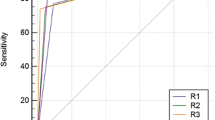Abstract
Here, we report a case of a 64-year-old female with acute-onset vertigo, nausea, and vomiting. In an emergency imaging examination, the results of computed tomography (CT) and diffusion weighted imaging (DWI) were negative. However, on 1 day post-hospital admission, a small acute infarct in the posterolateral aspect of the left medulla was detected by DWI. Extra attention should be payed to the false-negative imaging results to avoid diagnosis and treatment delay.



Similar content being viewed by others
References
Edlow BL, Hurwitz S, Edlow JA (2017) Diagnosis of DWI-negative acute ischemic stroke: a meta-analysis. Neurology 89(3):256–262
Zhang DP, Zhang HT, Yin S, Yan FL (2016) Perfusion weighted imaging in the assessment of the pathology and outcomes of lateral medullary infarction. Neurosciences (Riyadh) 21(4):361–365
Kim JS (2003) Pure lateral medullary infarction: clinical-radiological correlation of 130 acute, consecutive patients. Brain 126(Pt 8):1864–1872. https://doi.org/10.1093/brain/awg169awg169
Xu Y, Liu L (2016) Ipsilateral hemiparesis and contralateral lower limb paresis caused by anterior cerebral artery territory infarct. Neurosciences 21(3):256–259
Qi X, Qiu J, De Stefano V, Shao X, Sun R, Guo X (2017) Development of acute ischemic stroke in two patients with acute upper gastrointestinal bleeding. 2. https://doi.org/10.21037/amj.2017.02.05
Kelly PJ, Hedley-Whyte ET, Primavera J, He J, Gonzalez RG (2001) Diffusion MRI in ischemic stroke compared to pathologically verified infarction. Neurology 56(7):914–920
Lansberg MG, Albers GW, Beaulieu C, Marks MP (2000) Comparison of diffusion-weighted MRI and CT in acute stroke. Neurology 54(8):1557–1561
Shono K, Satomi J, Tada Y, Kanematsu Y, Yamamoto N, Izumi Y, Kaji R, Harada M, Nagahiro S (2017) Optimal timing of diffusion-weighted imaging to avoid false-negative findings in patients with transient ischemic attack. Stroke 48(7):1990–1992
Le Bihan D, Breton E, Lallemand D, Grenier P, Cabanis E, Laval-Jeantet M (1986) MR imaging of intravoxel incoherent motions: application to diffusion and perfusion in neurologic disorders. Radiology 161(2):401–407. https://doi.org/10.1148/radiology.161.2.3763909
Lovblad KO, Laubach HJ, Baird AE, Curtin F, Schlaug G, Edelman RR, Warach S (1998) Clinical experience with diffusion-weighted MR in patients with acute stroke. AJNR Am J Neuroradiol 19(6):1061–1066
Oppenheim C, Stanescu R, Dormont D, Crozier S, Marro B, Samson Y, Rancurel G, Marsault C (2000) False-negative diffusion-weighted MR findings in acute ischemic stroke. AJNR Am J Neuroradiol 21(8):1434–1440
Sylaja PN, Coutts SB, Krol A, Hill MD, Demchuk AM, Group VS (2008) When to expect negative diffusion-weighted images in stroke and transient ischemic attack. Stroke 39(6):1898–1900
Rahul R, Sharma VK, Chan BP (2008) Diffusion-negative MRI in acute ischemic stroke: a case report. Cases J 1(1):1–3
Chalela JA, Kidwell CS, Nentwich LM, Luby M, Butman JA, Demchuk AM, Hill MD, Patronas N, Latour L, Warach S (2007) Magnetic resonance imaging and computed tomography in emergency assessment of patients with suspected acute stroke: a prospective comparison. Lancet 369(9558):293–298
Hossmann KA (1994) Viability thresholds and the penumbra of focal ischemia. Ann Neurol 36(4):557–565. https://doi.org/10.1002/ana.410360404
Williams CE, Gunn A, Gluckman PD (1991) Time course of intracellular edema and epileptiform activity following prenatal cerebral ischemia in sheep. Stroke 22(4):516–521
Srinivasan A, Goyal M, Al AF, Lum C (2006) State-of-the-art imaging of acute stroke. Radiographics Rev Publ Radiol Soc North Am Inc 26(Suppl 1):S75
Davis D, Ulatowski J, Eleff S, Izuta M, Mori S, Shungu D, van Zijl PC (1994) Rapid monitoring of changes in water diffusion coefficients during reversible ischemia in cat and rat brain. Magn Reson Med 31(4):454–460
Minematsu K, Li L, Sotak CH, Davis MA, Fisher M (1992) Reversible focal ischemic injury demonstrated by diffusion-weighted magnetic resonance imaging in rats. Stroke 23(9):1304–1310 discussion 1310-1301
Firlik AD, Rubin G, Yonas H, Wechsler LR (1998) Relation between cerebral blood flow and neurologic deficit resolution in acute ischemic stroke. Neurology 51(1):177–182
Lecouvet FE, Duprez TP, Raymackers JM, Peeters A, Cosnard G (1999) Resolution of early diffusion-weighted and FLAIR MRI abnormalities in a patient with TIA. Neurology 52(5):1085–1087
Kidwell CS, Alger JR, Di Salle F, Starkman S, Villablanca P, Bentson J, Saver JL (1999) Diffusion MRI in patients with transient ischemic attacks. Stroke 30(6):1174–1180
Li F, Silva MD, Sotak CH, Fisher M (2000) Temporal evolution of ischemic injury evaluated with diffusion-, perfusion-, and T2-weighted MRI. Neurology 54(3):689–696
Küker W, Weise J, Krapf H, Schmidt F, Friese S, Bähr M (2002) MRI characteristics of acute and subacute brainstem and thalamic infarctions: value of T2- and diffusion-weighted sequences. J Neurol 249(1):33–42
Tang Y, Pacary E, Fréret T, Divoux D, Petit E, Schumann-Bard P, Bernaudin M (2006) Effect of hypoxic preconditioning on brain genomic response before and following ischemia in the adult mouse: identification of potential neuroprotective candidate for stroke. Neurobiol Dis 21(1):18–28
Yenari M, Kitagawa K, Lyden P, Perez-Pinzon M (2008) Metabolic downregulation: a key to successful neuroprotection? Stroke 39(10):2910–2917
Zemke D, Smith JL, Reeves MJ, Majid A (2004) Ischemia and ischemic tolerance in the brain: an overview. Neurotoxicology 25(6):895–904
Dirnagl U, Becker K, Meisel A (2009) Preconditioning and tolerance against cerebral ischaemia: from experimental strategies to clinical use. Lancet Neurol 8(4):398–412
Paciaroni M, Pantoni L (2017) Thrombolysis in dementia patients with acute stroke: is it justified? Neurol Sci 38(1):27–31. https://doi.org/10.1007/s10072-016-2725-410.1007/s10072-016-2725-4
Author information
Authors and Affiliations
Corresponding author
Ethics declarations
Conflict of interest
The authors declare that they have no conflict of interest.
Rights and permissions
About this article
Cite this article
Wang, Y., Liu, Y., Wang, Y. et al. False-negative diagnostic imaging of Wallenberg’s syndrome by diffuse-weighted imaging: a case report and literature review. Neurol Sci 39, 1657–1661 (2018). https://doi.org/10.1007/s10072-018-3399-x
Received:
Accepted:
Published:
Issue Date:
DOI: https://doi.org/10.1007/s10072-018-3399-x




